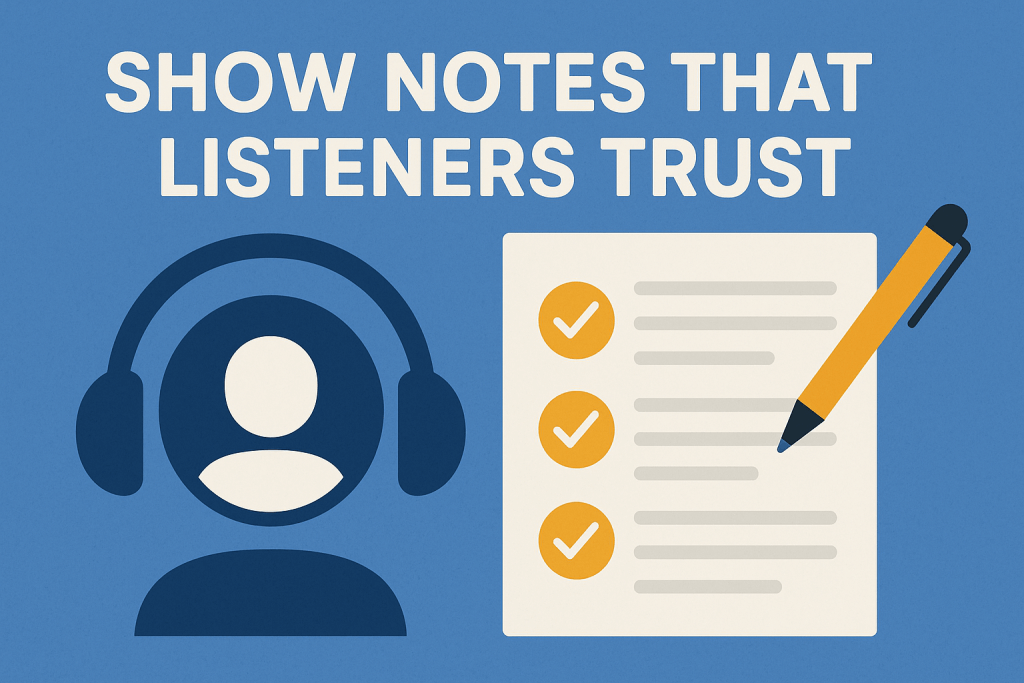Great episodes deserve notes that help people replay ideas, follow sources, and share a clear quote without scrubbing through an hour of audio. Listeners open show notes when curiosity spikes or when a guest says something worth saving. If notes feel messy, they close the tab and bookmark nothing. A simple structure fixes that. Write with the ear in mind, label links in plain words, and give time marks that match the player clock. Keep claims tight, sources clean, and tone steady. The goal is to make the listening day smoother: fewer dead links, faster re-listens, and a clear path for anyone who came for one idea but stayed for the voice.
What Listeners Expect From Show Notes
Listeners want three things in the first screen: a one-line idea of the episode, a tight list of what is inside, and links that behave. That one line should say what the episode does, not sell the show. The inside list works best when it mirrors how the talk flows – setup, story, steps. Links should point to sources the guest actually used, not broad homepages or noisy search results. When the episode covers a tool, say why it appears. When it touches a claim, show where the claim came from. If a quote will be repeated online, give the time mark and a short context tag so it stands up when shared without the rest.
Link choices carry weight because people follow them on phones during a commute. Treat the page like a map, not a promo rail. When a segment dissects the way risky apps frame “odds talk,” reference external pages as case studies with neutral, careful wording – for instance, “In media literacy segments, scripts sometimes analyze how this website or similar pages present streaks and resets; treat such links as reading samples, not invites.” That style protects young listeners, keeps standards clear for guests, and signals that your show takes care with outbound clicks. Labeling and intent matter more than volume. A few clean links beat a pile that looks busy and blurs trust.
A Link Policy That Protects Listeners And Hosts
A simple policy makes decisions easy on long days. Write it once, share it with producers and guests, and apply it the same way every week. The policy should cover how you vet sources, how you label them, and how you gate anything that might be age-limited or sensitive. It should also spell out what you never link to directly and how you handle news that changes fast. Consistency saves time in edits, reduces back-and-forth with legal, and keeps the show’s voice steady even when topics jump from culture to tech to money in a single month. When a team can point to a short rule set, debates end sooner and better.
- Label links by what they do (“dataset,” “court filing,” “player FAQ”), not by vague names. Add a note if sign-in is needed. Gate sensitive examples with a plain warning and neutral language. Prefer primary sources over summaries. Snapshot fast-changing pages with a date line. Avoid affiliate tones; if you must disclose a tie, do it in clear, calm words.
Chapters, Quotes, And Sources That Speed Replays
Chapters help listeners jump to value on the second pass. Use clear verbs in chapter names, keep them short, and align them with where a topic shifts in the audio, not where breaths happen. Quotes belong near those chapters, written as clean sentences that hold outside the show page. If a guest shares a number, add one line of context so it does not float. For sources, pick two that carry weight and that a careful reader can check in under a minute. When an item sits behind a paywall, tell people; they will still appreciate the clarity. Every tiny label that tells the truth reduces support emails and grows long-term trust.
Fact Checks That Catch Problems Before Publish
A quick, firm check saves hours later. Read the one-line episode idea aloud and ask if it matches the audio. Click every link on a clean device that is not logged in to anything. Confirm that time marks jump to the right spots and that quotes match what is said. Search the guest’s name plus the main claim and look for corrections you should mention. If a risky example appears, make sure the copy frames it as analysis, not as advice, and keep any brand mention to the smallest needed form. This pass takes fifteen minutes when the system is in place; it takes a day when notes try to do everything at once without a clear plan.
Make Notes A Habit, Not A Chore
Strong notes come from a small, repeatable flow. Draft a one-line idea first, drop in chapter names as the edit settles, add two primary sources, and label links with what they do. Keep the voice plain, the labels honest, and the page tidy on phones. After publish, watch what listeners click and which quotes travel. Trim what no one uses. Save a template with the headings, the labeling rules, and the fact-check steps so the next episode starts fast. When this rhythm takes hold, guests feel cared for, listeners trust the page, and show notes move from an afterthought to a quiet edge – the place where the episode keeps working long after the last word fades.
Cassia Rowley is the mastermind behind advertising at The Bad Pod. She blends creativity with strategy to make sure ads on our site do more than just show up—they spark interest and make connections. Cassia turns simple ad placements into engaging experiences that mesh seamlessly with our content, truly capturing the attention of our audience.


